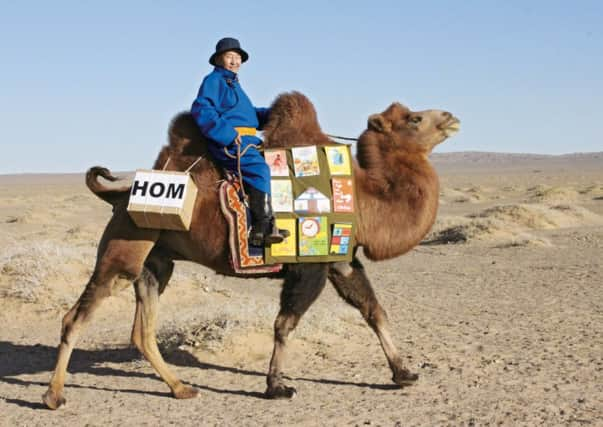Important role of animals celebrated in new book


Traditional libraries are expensive to build and are generally beyond the reach of impoverished and remote rural communities. Mobile libraries are the obvious solution, but motor vehicles can be expensive to run and require good and reliable roads. Libraries carried by animals, however, can travel over rough ground in areas with limited infrastructure, have low running costs and are extremely environmentally friendly. There are many examples around the world of well-loved animals helping to provide library services for children and adults in otherwise inaccessible places.
Horse-drawn bookmobiles were the earliest libraries to serve the vast, thinly populated rural areas of the US during the early 20th century. The first was set up in 1905 by Mary Titcomb of the Washington County Free Library in Maryland. A wagon carried boxes of books to the general store or post office in small towns throughout the county. The design of the library wagon was quite discreet until one farmer who saw it approach mistook it for a funeral hearse and turned it away, at which point it was painted red.
Advertisement
Hide AdBiblioburro is a travelling library in Colombia that distributes books to communities in the country’s Caribbean hinterlands from pouches carried on the backs of two donkeys, Alfa and Beto. Established by primary school teacher Luis Soriano, the original starting library of 70 books has now grown to more than 5,000 and the project has become a family affair with his wife and children helping with the administration. Children’s adventure stories are one of the most popular genres stocked by the Biblioburros, which also carry a range of fiction, encyclopaedias and medical textbooks. Luis, who also had his left leg amputated after an accident involving one of the biblioburros in 2012, says: “We work voluntarily with very few resources but with plenty of blood, sweat and tears, although we also work for the love of it.”
Donkeys have also been a key element of the mobile library service run by Ethiopia Reads since 2005, although they are now being phased out as part of a new programme that uses horses and motorcycles. In addition to providing books, the travelling librarians teach lessons in Amharic, English, maths and science to local children several times a week. As Jennifer Martin from the organisation explains: “The librarian enters the village and calls the children in from the fields, where they are working as shepherds and farmers or out collecting water. They gather under the shade of a big tree for a lesson. Up to 200 children meet at a time.”
Remote mountain villages in Venezuela receive library books from mules via the Bibliomulas project initiated by the University of Momboy in 2010. Operating under the guidance of Professor Rosalía Ramírez, it now has two mules, Cenizo and Canela (a third, Golondrina, was stolen at the start of 2013), looked after by “bibliomuleros” Nelson Salcedo and Ruben Vasquez. In addition to carrying books, Bibliomulas also brings laptops and wireless modems to the villages, many of which have limited mobile phone signal coverage, to help residents take advantage of what little signal there is.
Big Brother Mouse is a non-profit Laos-based charity which has been publishing books in the Lao language since 2006, as well as organising teacher-training sessions and book parties in rural villages, and operating a bookshop in Vientiane.
The staff also run reading tests in rural schools, measuring improvement over the course of a year. Many villages are not on a road network and can only be reached by boat or on foot. Now, thanks to Big Brother Mouse, some communities in Sainyabuli Province are visited by a mobile library carried by an elephant called Boom-Boom (“boom” means “book” in Lao). According to the organisers, children have always been excited when the Big Brother Mouse team arrives in their village, but are even more excited now that they arrive with an elephant. Traditional Lao fairy tales are the most popular titles, followed by books about sea life, insects and dinosaurs. Older readers are keen on Lao cookbooks, which are otherwise not widely available.
Mongolian author Jambyn Dashdondog has not only written dozens of children’s books and poetry collections, but for the past 20 years he has personally ridden a camel – as well as horses, cows and reindeer – to bring books to younger readers all around the country as part of his long-running Mongolian Children’s Mobile Library project, which began working in partnership with the charity Go Help in 2011. There are also several camel-based “bookmobiles” in Kenya, the first set up in 1985 by the Kenya National Library Service. These camel libraries make regular visits to villages, especially in the drought stricken eastern part of the country.
Advertisement
Hide AdIn many of the most remote areas around the world, the mobile library stays true to its horse-powered predecessors. Whether by horse, donkey, mule, elephant or camel, these tried and tested traditional methods of haulage are still preferred by librarians even after a century of motorised power. n
• This is an edited extract from Improbable Libraries by Alex Johnson, published tomorrow by Thames & Hudson
FOLLOW US
SCOTSMAN TABLET AND MOBILE APPS